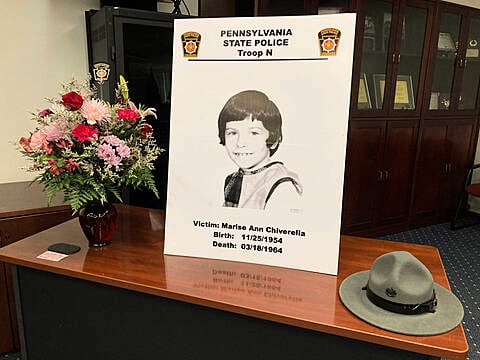DNA evidence and a 20-year-old genealogy expert helped US state police identify the man who abducted, raped and murdered a young girl in a Pennsylvania coal town nearly six decades ago.
Officers exhumed the long-dead assailant’s body last month and said his profile precisely matched DNA left on the jacket of the victim, nine-year-old Marise Ann Chiverella, who was snatched on the morning of March 18 1964 as she walked to school in Hazleton, about 80 miles north of Philadelphia.
Her body was found that afternoon in a nearby waste coal pit. Authorities say she had been raped and strangled.
Police identified her killer as James Paul Forte, a bartender with a record of violent sexual assault, who died of natural causes in 1980 at the age of 38.

Forte, who was 22 at the time of the murder, had no known connection to the little girl or her family, officers said.
Generations of state police investigators pursued Marise’s killer – more than 230 members of the department were involved in the probe at one time or another – but Forte’s name did not come up until 2020.
By that time, new DNA technology had established a distant family connection to Forte, and Eric Schubert, a college student and expert in genetic genealogy who had volunteered to work on the case, put together an extensive family tree that helped investigators narrow their suspect list.
State police made the announcement at a news conference packed with current and retired investigators – including the trooper who first probed Marise’s murder – and the little girl’s four siblings and extended family.

Her siblings called Marise a sweet and shy girl who was learning to play the organ and aspired to be a nun.
The girl’s sister, Carmen Marie Radtke, said: “We have so many precious memories of Marise. At the same time, our family will always feel the emptiness and sorrow of her absence.
“We will continue to ask ourselves: what would have been, what could have been?”
She said their deceased parents never sought revenge, but justice.
“Thanks to the Pennsylvania State Police, justice has been served today,” she said.
A history major at Elizabethtown College in Pennsylvania and proprietor of ES Genealogy, Mr Schubert developed an interest in the discipline as a young boy and had helped other police agencies crack their cold cases using genetic genealogy, which blends the use of DNA testing with traditional genealogical research.
Mr Schubert was looking for a new case to work on when he ran across Marise’s story, and offered his services to Pennsylvania State Police.

He was pleasantly surprised when they accepted and spent the next two years on the case, working side by side with investigators.
The 20-year-old said: “The investigation that went into all of this work was probably the hardest genealogy task that I’ve ever faced.
“This was probably the hardest thing that I’ve ever done in my entire life. And it means so much to me that I was able to be on the team that could provide answers to the Chiverella family.”
At a certain point, he said: “I knew we were going to find the assailant.”
State police Cpl Mark Baron, the lead investigator, said it was believed to be the fourth-oldest cold case in the US to be solved using genetic genealogy, and the oldest in Pennsylvania.
Cpl Baron, who choked up as he spoke, called it an important day for Marise’s family and for a community that had long been haunted by her death.
“It’s a vivid memory for everybody who lived through this, and it’s a vivid memory for everybody who grew up in this area,” he said.
“What happened to her ushered in a change in this community. Whether you like it or not, the way you lived changed after March 18 of 1964 in Hazleton.”







